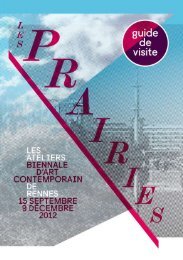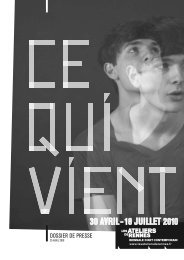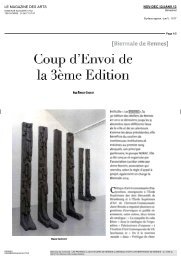Download here the Visitor's guide. - Les Ateliers de Rennes
Download here the Visitor's guide. - Les Ateliers de Rennes
Download here the Visitor's guide. - Les Ateliers de Rennes
You also want an ePaper? Increase the reach of your titles
YUMPU automatically turns print PDFs into web optimized ePapers that Google loves.
34<br />
<strong>Les</strong> Prairies's artists<br />
MATHIEU KLEYEBE ABONNENC<br />
Movie poster for Africa Addio.<br />
Directed by Gualtiero Jacopetti and Franco Prosperi, 1966. D.R.<br />
Co-production<br />
<strong>Les</strong> <strong>Ateliers</strong> <strong>de</strong> <strong>Rennes</strong> 2012,<br />
Frac Bretagne,<br />
Pavilion, Leeds,<br />
Ecole <strong>de</strong>s Beaux-Arts <strong>de</strong><br />
Nantes Métropole.<br />
Mathieu Abonnenc explores <strong>the</strong><br />
colonial past. He works on figures<br />
and events that official history has<br />
suppressed. In Des corps entassés<br />
('piled bodies'), <strong>the</strong> first part of a longterm<br />
project, his ongoing research,<br />
always un<strong>de</strong>rpinned by in-<strong>de</strong>pth<br />
study of precise situations, focuses<br />
on copper (malachite), a material that<br />
was one of <strong>the</strong> causes of <strong>the</strong> Katanga<br />
War of Secession and, before that,<br />
of <strong>the</strong> West's interest in <strong>the</strong> territory.<br />
Abonnenc's film shows a dozen<br />
Katanga crosses being melted down<br />
in an English foundry and <strong>the</strong>n cast<br />
into a bar whose length corresponds<br />
to that of an average human being.<br />
For centuries (from <strong>the</strong> 10th century<br />
up to Belgian colonisation in <strong>the</strong> 19th<br />
century) <strong>the</strong>se crosses were used as<br />
currency in Central Africa. The brutal<br />
act of appropriation represented in<br />
<strong>the</strong> film is inten<strong>de</strong>d as an echo of<br />
Belgian appropriation of <strong>the</strong> entire<br />
reserves of Katanga crosses. The film<br />
is accompanied by commentaries<br />
relating several stories. Some of<br />
<strong>the</strong> stories <strong>de</strong>al with phenomena of<br />
cultural appropriation and <strong>the</strong> ensuing<br />
violence; o<strong>the</strong>rs are a narration of<br />
aes<strong>the</strong>tic facts that bring out <strong>the</strong><br />
connotations of choice of material or<br />
of production styles, in o<strong>the</strong>r words<br />
<strong>the</strong>ir political and ethical significance.<br />
No material is neutral. It implicates<br />
and recounts human lives. Through<br />
<strong>the</strong> story of a mineral, Abonnenc<br />
reconstitutes an episo<strong>de</strong> in <strong>the</strong> history<br />
of capitalism and its mechanisms,<br />
showing <strong>the</strong> effects of industrialisation<br />
by European nations on colonised<br />
nations and populations. The film is<br />
presented along with several copper<br />
bars in a scenography whose spatial<br />
constraints <strong>de</strong>note authority.<br />
A. B. tr. J.H.<br />
Born in 1977 in Guyana (France),<br />
lives and works in Paris (France).






